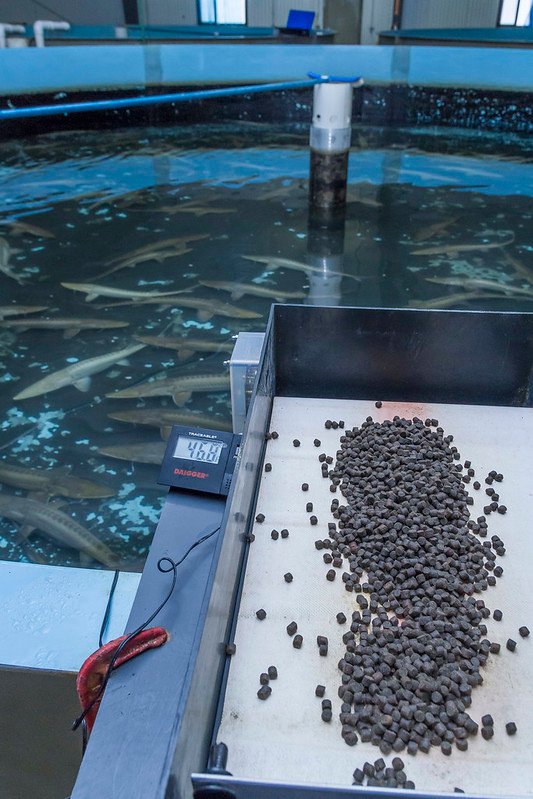
A key concern among shrimp farmers is finding sustainable and effective ways to optimize shrimp growth and health through feeding. In this regard, microalgae have emerged as a great alternative to supplement shrimp feed; however, lipid accumulation could pose problems.
A new study published in the scientific journal Plos One by scientists from the National Institute of Oceanography and Fisheries (NIOF), Al-Azhar University (Egypt), Central Laboratory for Aquaculture Research (ARC), King Saud University (Saudi Arabia), University of Galway (Ireland), and Zagazig University (Egypt) has shed light on a possible solution: the microalga “spirulina” Arthrospira platensis. This research studied the impact of including A. platensis (whole dried biomass and lipid-free biomass) in the diet of Pacific white shrimp (Litopenaeus vannamei), a commercially important species.
Unlocking the Potential of Spirulina A. platensis
Microalgae like A. platensis are gaining traction in aquaculture due to their rich nutritional profile:
- High protein content: Provides essential elements for growth.
- Unsaturated fatty acids: Promote healthy shrimp development.
- Antioxidant pigments: Boost the immune system and combat oxidative stress.
- Vitamins and minerals: Support various physiological functions.
While A. platensis offers numerous benefits, its high lipid content can be a double-edged sword. Excessive lipid accumulation in shrimp can lead to health problems. Lipid-free biomass (FL), a by-product of biodiesel production from A. platensis, offers a solution. By removing the lipids, researchers are unlocking the health benefits of spirulina while minimizing potential drawbacks.
What the Researchers Did
The researchers studied the impact of adding Arthrospira platensis, specifically the NIOF17/003 strain, to the diet of shrimp postlarvae. They compared five different diets:
- Control (C-N): No supplementation with A. platensis.
- Positive Control (C-P20): Standard commercial diet with 2% dried A. platensis.
- FL Diets (FL10, FL20, FL30): Commercial diet supplemented with graded levels (1%, 2%, and 3%) of lipid-free (FL) biomass extracted from A. platensis.
The researchers then analyzed growth performance, body composition, immune response, antioxidant activity, and gene expression in the shrimp.
Key Findings
The group fed a diet containing 1% FL exhibited the most significant improvements. These shrimp had:
- Faster growth and better feed conversion efficiency (meaning they used their feed more effectively).
- Higher survival rates.
- Improved body composition, with higher protein, lipid, and ash content.
Diets containing A. platensis, both whole and FL, also led to:
Stay Always Informed
Join our communities to instantly receive the most important news, reports, and analysis from the aquaculture industry.
- Enhanced digestive enzyme activity.
- Stronger innate immune response, making the shrimp more resistant to diseases.
- Boosted antioxidant activity, protecting cells from damage.
This study suggests that including A. platensis, particularly the FL component, in shrimp diets can significantly improve their health and growth.
Implications for Shrimp Aquaculture
This research offers a potentially sustainable and natural way to enhance shrimp production.
- A. platensis is an easily available microalga, making it a potentially cost-effective supplement.
- Further research is needed to optimize the use of A. platensis in commercial aquaculture settings.
Overall, this study presents a promising avenue for improving shrimp health and promoting sustainable aquaculture practices.
Conclusion for Shrimp Producers
The study revealed that lipid-free biomass from A. platensis, compared to the whole dried form, could enhance shrimp growth performance, body chemical composition, antioxidant activity, and immune responses.
This research highlights the potential of Arthrospira platensis, particularly its lipid-free biomass, as a powerful dietary supplement for Pacific white shrimp. Supplementing shrimp feed with 1% FL appears to be the most effective approach to promoting growth, health, and survival rates.
Contact
Simon Davies
School of Natural Sciences, Ryan Institute, University of Galway
Galway, Ireland
Email: Simon.davies@universityofgalway.ie
Reference (open access)
Ashour, M., Mabrouk, M. M., A. Mansour, A. I., Abdelhamid, A. F., AbdEl Kader, M. F., Elokaby, M. A., El-Nawsany, M. M., Abdelwarith, A. A., Younis, E. M., Davies, S. J., El-Haroun, E., & E. Naiel, M. A. (2024). Impact of dietary administration of Arthrospira platensis free-lipid biomass on growth performance, body composition, redox status, immune responses, and some related genes of pacific whiteleg shrimp, Litopenaeus vannamei. PLOS ONE, 19(6), e0300748. https://doi.org/10.1371/journal.pone.0300748
Editor at the digital magazine AquaHoy. He holds a degree in Aquaculture Biology from the National University of Santa (UNS) and a Master’s degree in Science and Innovation Management from the Polytechnic University of Valencia, with postgraduate diplomas in Business Innovation and Innovation Management. He possesses extensive experience in the aquaculture and fisheries sector, having led the Fisheries Innovation Unit of the National Program for Innovation in Fisheries and Aquaculture (PNIPA). He has served as a senior consultant in technology watch, an innovation project formulator and advisor, and a lecturer at UNS. He is a member of the Peruvian College of Biologists and was recognized by the World Aquaculture Society (WAS) in 2016 for his contribution to aquaculture.



